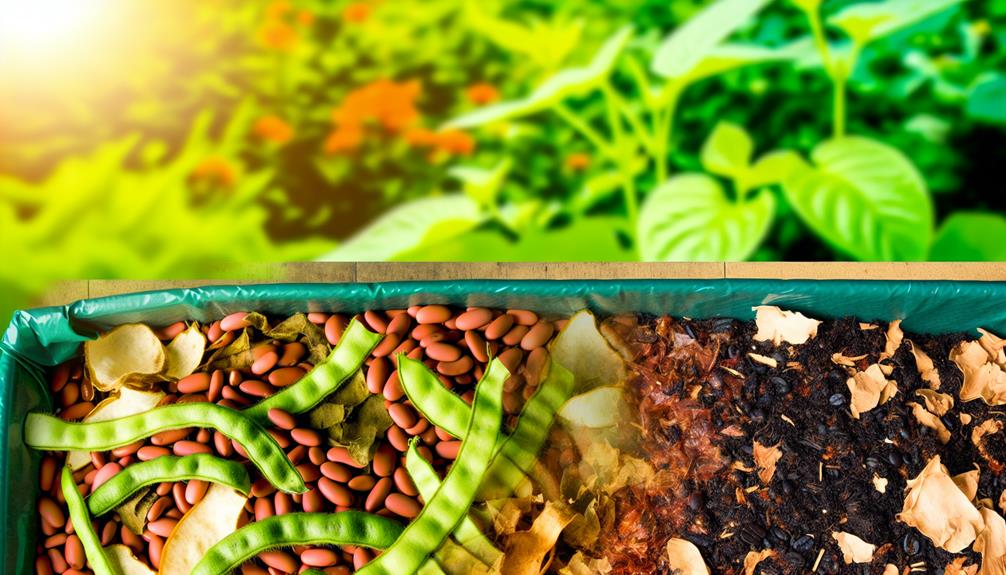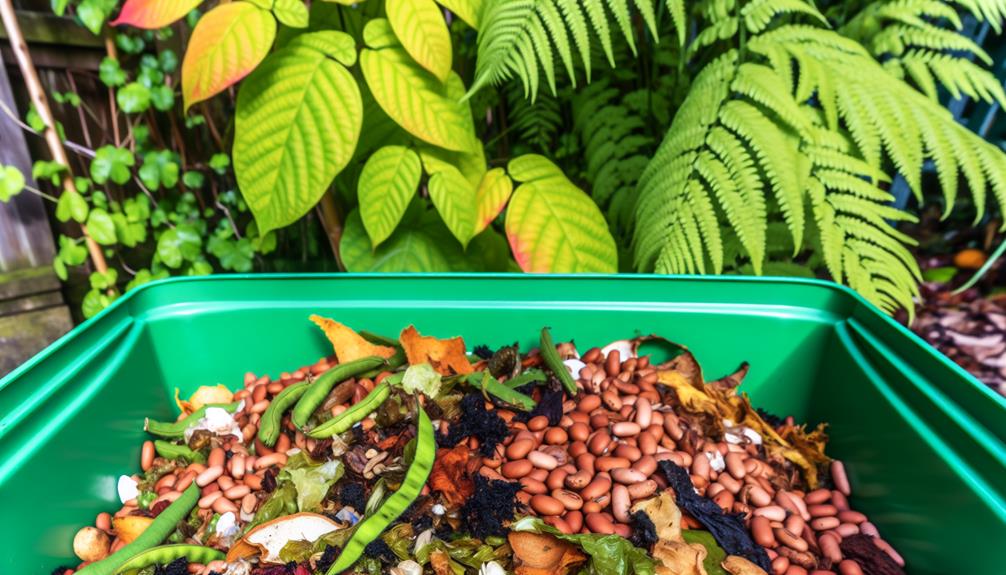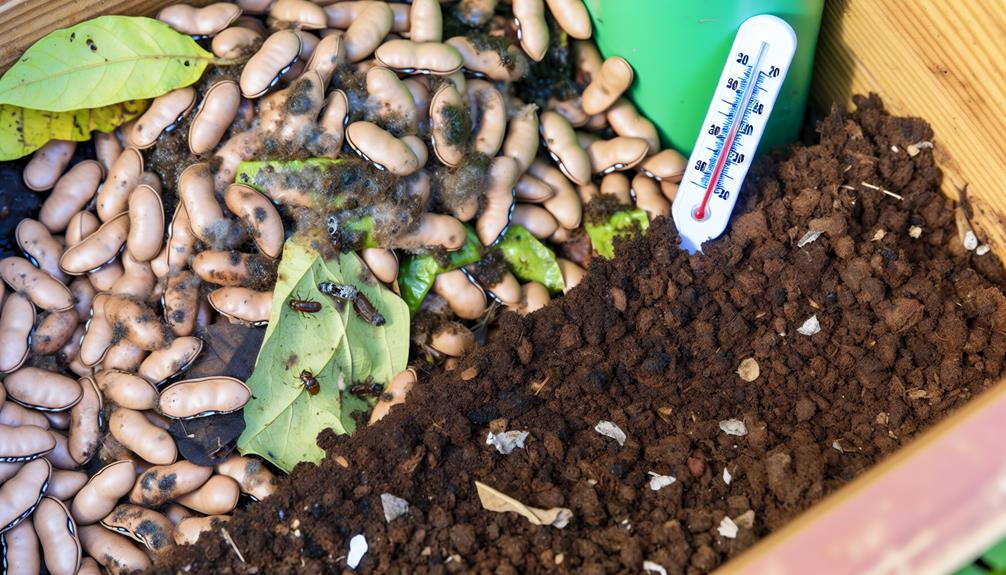

You can compost pinto beans, but it’s advisable to cook them first to speed up their decomposition. Combine them with a mix of green materials like vegetable scraps and brown materials such as dried leaves to maintain a balanced compost. Make sure the compost pile stays moist but not soggy, and turn it regularly to provide oxygen and promote microbial activity.
Properly composted pinto beans will help enrich your soil with valuable nutrients. Keep going for more tips on composting kitchen scraps and troubleshooting common issues.
Composting is a natural process that turns organic waste into nutrient-rich soil, perfect for gardening and reducing landfill waste. It’s an easy way to recycle kitchen scraps, yard waste, and other organic materials. By understanding the basics of composting, you can contribute to a healthier environment and create valuable compost for your garden.
First, let’s look at some common composting methods:
When starting your compost, balance green materials like fruit and vegetable scraps with brown materials such as leaves and cardboard. This balance helps facilitate proper decomposition and prevents odors.
Always keep your compost moist but not soggy, and turn it regularly to introduce oxygen. By following these guidelines, you’ll establish a thriving compost system that transforms organic waste into valuable soil amendment.
Utilizing kitchen scraps like fruit peels, coffee grounds, and vegetable trimmings can greatly enrich your compost pile. These materials provide essential nutrients that help your compost break down more efficiently.

When composting kitchen scraps, it’s important to balance ‘greens’ and ‘browns’ to maintain a healthy composting process. Greens, like vegetable trimmings and coffee grounds, offer nitrogen, while browns, such as dried leaves and cardboard, provide carbon.
Composting eggshells is a fantastic way to add calcium to your compost. Crush the eggshells before adding them to speed up their decomposition. Calcium helps strengthen the cell walls of plants, promoting healthy growth.
Coffee grounds are another excellent addition, as they’re rich in nitrogen which accelerates the composting process. When composting coffee, remember to include the paper filters if they’re unbleached, as they’re also compostable.
To ensure your compost pile thrives, regularly turn it to aerate and mix the materials. This helps microorganisms break down the organic matter more effectively.
Also Read: Can You Compost Cat Manure?
While kitchen scraps greatly boost your compost’s nutrient content, adding pinto beans can further enhance the richness of your compost pile. Pinto beans are a fantastic addition because they break down well and supply essential nutrients. To get started, you’ll need to make sure your compost bin is properly balanced.
First, keep in mind that pinto beans should be cooked before composting. Raw beans can take longer to decompose and may attract pests.
Here are some essential tips to follow:
Composting pinto beans offers several benefits you shouldn’t overlook. First, it creates nutrient-rich soil that can enhance your garden’s productivity.
Additionally, it helps reduce food waste and boosts microbial activity, which further enriches your compost.
Adding composted pinto beans to your garden soil can greatly enhance its nutrient content. When you incorporate these beans into your compost, they break down and release crucial nutrients that plants need to thrive. Using composted pinto beans as soil amendments guarantees your garden gets a balanced mix of nitrogen, phosphorus, and potassium.
To get started, mix your composted pinto beans into the soil before planting. This will help the nutrients integrate effectively. If you’re using compost tea, simply soak the compost in water, strain it, and then water your plants with the nutrient-rich liquid. This method ensures that your plants receive an immediate nutrient boost.
Transforming pinto beans into compost greatly reduces food waste, turning what would be discarded into valuable garden nutrients. By composting these beans, you’re actively participating in effective waste management. Instead of letting pinto beans rot in a landfill, you can repurpose them into a rich, organic matter that benefits your garden.
Composting pinto beans also promotes food preservation in a broader sense. When you compost, you’re essentially recycling nutrients back into the soil, making it more fertile for future crops. This process guarantees that nutrients from the beans aren’t wasted but are instead put to good use, fostering a sustainable cycle of food production and consumption.
To get started, collect your pinto bean scraps and mix them with other compostable materials like vegetable peels and coffee grounds. Turn your compost pile regularly to maintain proper aeration and decomposition. By doing this, you’re creating an environment where organic waste is transformed into something beneficial.
Incorporating pinto beans into your compost routine is a simple yet effective step towards better waste management. You’re not just reducing food waste; you’re contributing to a healthier ecosystem. So, embrace this practice and watch your garden thrive.
Enhanced microbial activity in your compost pile accelerates the breakdown of organic matter, turning pinto beans into nutrient-rich soil. When you add pinto beans to your compost, you boost the decomposition rate substantially. These beans are packed with proteins and carbohydrates, which serve as food for microbes.
To see the benefits, make sure your compost pile has:
By following these steps, you create an environment where microbes thrive, increasing the speed at which organic matter decomposes. Pinto beans, being relatively small and soft, break down faster than tougher materials, contributing to a more dynamic microbial community.
This enhanced microbial diversity ensures that different types of organic matter decompose efficiently.
Incorporating pinto beans into your compost not only reduces waste but also enriches your soil with essential nutrients. By optimizing conditions for microbial activity, you transform your compost pile into a powerhouse of soil fertility, benefiting your garden and the environment.
Also Read: Can You Compost Cardboard?
Composting pinto beans can attract unwanted pests to your compost pile. While it might seem like a minor issue, the increased presence of rodents, raccoons, and insects can create problems.
To combat this, you’ll need to pay close attention to moisture levels. Pinto beans can retain a lot of water, which can upset the balance of your compost. Too much moisture can lead to anaerobic conditions, fostering bad smells and slowing down the composting process.
Odor management is another challenge. Pinto beans, especially when cooked, can produce strong odors as they break down. This can not only attract pests but also make your compost pile unpleasant for you and your neighbors.
Ensuring that your compost pile is well-aerated can help manage these odors. Regularly turning your compost and mixing in dry materials like leaves or straw can help balance out the moisture and keep odors in check.
Lastly, be mindful of the overall balance of your compost. Adding too many pinto beans at once can overwhelm your pile, making it harder to manage. Spread out their addition over time to maintain a healthy compost environment.
Before adding pinto beans to your compost, you’ll need to take some steps to prepare them properly. Pinto beans can be a great addition to your compost pile, but they need a bit of attention first.
Here’s what you should do:
After preparing your pinto beans, it’s important to balance your compost ingredients to guarantee efficient decomposition. Maintaining the right carbon ratio is key to successful composting. Your compost pile should include both green materials, which are rich in nitrogen, and brown materials, which are rich in carbon. Pinto beans, as green materials, need to be balanced with brown materials like leaves, straw, or cardboard.
To visualize this balance, consider the following table:
| Green Materials | Brown Materials | Ratio |
|---|---|---|
| Pinto beans | Dried leaves | 1 part beans |
| Grass clippings | Straw | 2 parts grass |
| Vegetable scraps | Cardboard | 1 part scraps |
A well-balanced compost pile should ideally have a carbon-to-nitrogen ratio of about 30:1. This means for every part green material, you should add approximately 2-3 parts brown material. For example, if you’re adding one bucket of pinto beans, you’ll need to add two to three buckets of dried leaves or other brown materials to maintain the proper ratio.
Always keep your compost pile moist but not soggy, and turn it regularly to ensure proper aeration. This balance will create an effective and efficient composting process, fostering a sense of accomplishment and belonging in your gardening community.
Also Read: Can You Compost Butter?
Encountering problems in your composting process can be frustrating, but identifying and addressing common issues will help you achieve best results. Composting challenges are common, and knowing how to troubleshoot them can make a big difference.

Here are some troubleshooting tips to get you back on track:
Odor Issues:
If your compost pile smells bad, it’s often due to too much moisture or not enough aeration. Turn your pile more frequently and add dry, carbon-rich materials like leaves or shredded paper.
Slow Decomposition:
If your compost materials aren’t breaking down, the pile might be too dry or lack nitrogen. Moisten the pile and add green materials like grass clippings or kitchen scraps.
Pests:
Unwanted pests can be a sign of exposed food scraps. Make sure to cover new additions with a layer of soil or brown materials to deter critters.
To maximize the efficiency of composting pinto beans, implement these best practices to guarantee a healthy and productive compost pile. Start by storing your pinto beans properly. If you have uncooked beans, keep them in a cool, dry place. This prevents spoilage and confirms they’re in good condition when you decide to compost them.
When composting cooked pinto beans, follow some simple cooking tips to make the process smoother. Avoid adding excessive salt or oils during cooking, as these can hinder the composting process. Instead, cook your beans plain or with minimal seasoning.
In your compost pile, balance green and brown materials. Pinto beans are considered green materials, rich in nitrogen. To maintain this balance, mix them with brown materials like dried leaves or shredded paper, which are high in carbon.
Turn your compost pile regularly to aerate it and speed up decomposition. This also helps to distribute the pinto beans evenly.
Yes, they can attract pests if not properly managed. For effective pest prevention and compost maintenance, make sure you bury them deep and mix well with other materials. This helps keep your compost healthy and pest-free.
In ideal compost conditions, bean decomposition, including pinto beans, typically takes a few months. You’ll see faster results if you maintain the right moisture, aeration, and balance of green and brown materials in your pile.
You’ll find that both cooked and uncooked pinto beans work for composting. Just monitor moisture levels and nitrogen balance to make sure they break down properly, and you’ll be part of a thriving, eco-friendly community.
You’re wondering if pinto beans add a specific nutrient to compost. They boost soil enrichment by increasing nitrogen levels, a key nutrient. Including them enhances your garden’s health, making you part of a thriving gardening community.
You can compost pinto beans in a worm bin, but consider worm preferences. Proper bean preparation, like cooking and chopping them, makes it easier for worms to digest. Your worms will thrive, making you part of a sustainable community.
Yes, you can compost pinto beans. Make sure they’re properly prepared by removing any seasoning or sauces.
Balance your compost with a mix of greens and browns, like vegetable scraps and dry leaves.
Monitor moisture levels and turn the pile regularly to promote decomposition.
If you encounter issues, adjust the components as needed.
By following these steps, you’ll efficiently compost pinto beans and enhance your garden soil’s nutrient content.

Don't let aphids, slugs, and caterpillars ruin another plant. Take back control with simple, natural methods that actually work.